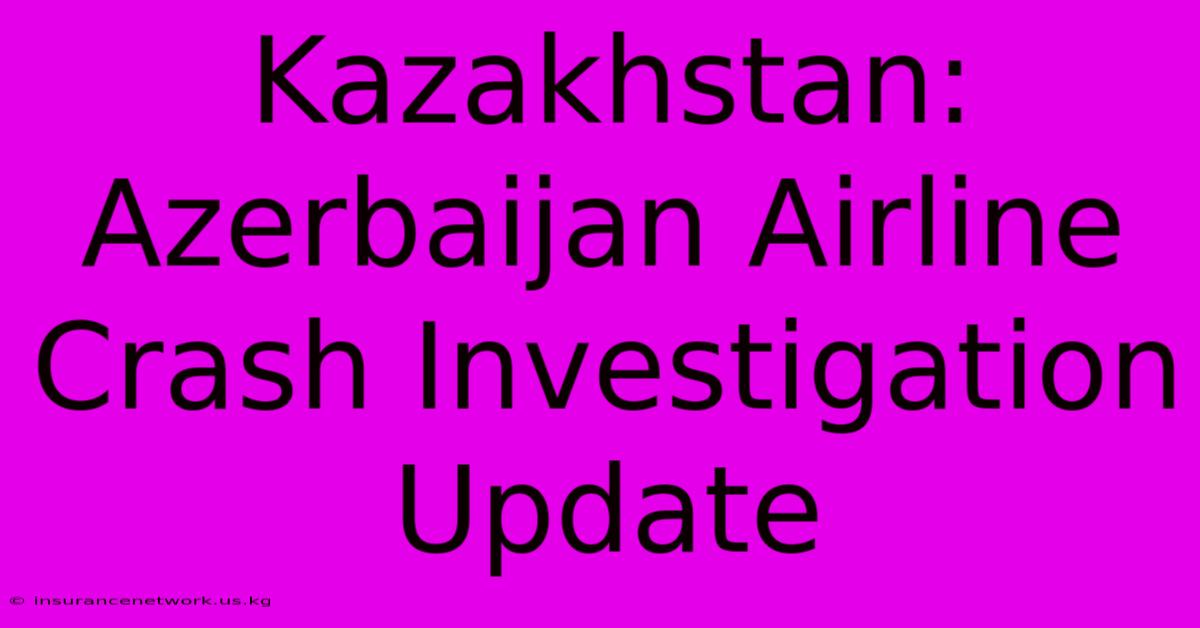Kazakhstan: Azerbaijan Airline Crash Investigation Update

Discover more detailed and exciting information on our website. Click the link below to start your adventure: Visit Best Website insurancenetwork.us.kg. Don't miss out!
Table of Contents
Kazakhstan: Azerbaijan Airlines Crash Investigation Update
The tragic plane crash involving Azerbaijan Airlines in Kazakhstan continues to send shockwaves throughout the region. This article provides the latest updates on the ongoing investigation into the incident, focusing on the crucial details emerging and the implications for aviation safety.
Timeline of Events and Initial Findings
The crash, which occurred on [Insert Date of Crash], involved an [Insert Aircraft Type] operated by Azerbaijan Airlines, flight number [Insert Flight Number]. The aircraft was en route from [Insert Departure City] to [Insert Destination City] when it encountered [brief description of the incident, e.g., severe weather conditions, mechanical failure]. Initial reports suggested [Insert early reports, e.g., a loss of contact with air traffic control, an emergency landing attempt].
The immediate aftermath saw emergency services swiftly deployed to the crash site near [Insert Location of Crash Site]. Sadly, [Insert number] lives were lost, with [Insert number] survivors. Rescue and recovery efforts were hampered by [mention challenges, e.g., difficult terrain, weather conditions].
Early investigations focused on [mention initial investigation areas, e.g., the aircraft's black boxes, witness testimonies, weather data]. Preliminary findings suggest [Insert any preliminary findings released by authorities, e.g., possible mechanical failure, adverse weather conditions as contributing factors]. However, it's crucial to understand that these are preliminary and the full investigation is far from complete.
The Ongoing Investigation: Key Aspects
The investigation is being conducted by a joint team comprised of experts from [mention participating countries and organizations, e.g., Kazakhstan, Azerbaijan, and international aviation safety agencies]. This collaborative approach is crucial to ensuring a thorough and impartial examination of all possible contributing factors.
Several key areas are under intense scrutiny:
1. Aircraft Maintenance and Technical Issues:
Investigators are meticulously examining the aircraft's maintenance records, focusing on its operational history, previous inspections, and any reported malfunctions. This includes a detailed analysis of the aircraft's flight data recorder (FDR) and cockpit voice recorder (CVR) data, which are vital to reconstructing the events leading up to the crash. The condition of the aircraft's engines, airframe, and critical systems is also being thoroughly assessed.
2. Pilot Performance and Crew Actions:
The investigation includes a comprehensive review of the pilots' qualifications, training, and experience. Investigators will analyze the cockpit voice recordings to assess crew communications, decision-making, and response to any unusual events. Any possible human error will be carefully considered, but it's essential to avoid premature conclusions.
3. Meteorological Conditions:
The weather conditions at the time of the accident are being analyzed in detail. Meteorological data will be scrutinized to determine if severe weather, such as turbulence or low visibility, contributed to the crash.
4. Air Traffic Control Communications:
The investigation will review all communications between the aircraft and air traffic control. Any anomalies or delays in communication will be examined to determine if they played a role in the accident.
Implications for Aviation Safety
The outcome of the investigation will have significant implications for aviation safety globally. Any identified shortcomings in aircraft maintenance, pilot training, or air traffic control procedures will lead to recommendations for improvements and enhanced safety protocols. This tragic event serves as a reminder of the importance of continuous vigilance in maintaining the highest standards of safety in air travel.
Conclusion
The investigation into the Azerbaijan Airlines crash in Kazakhstan is a complex and ongoing process. While early findings have been released, it is crucial to await the complete report before drawing definitive conclusions. The international collaboration involved in the investigation underscores the global commitment to learning from this tragedy and preventing similar incidents in the future. Updates will be provided as more information becomes available.

Thank you for visiting our website wich cover about Kazakhstan: Azerbaijan Airline Crash Investigation Update. We hope the information provided has been useful to you. Feel free to contact us if you have any questions or need further assistance. See you next time and dont miss to bookmark.
Featured Posts
-
Favorite Blazers Christmas Story
Dec 26, 2024
-
How Many Christmas Games For Nuggets
Dec 26, 2024
-
Azerbaijan Plane Crash In Kazakhstan What Happened
Dec 26, 2024
-
Swifts Absence Chiefs Steelers Game
Dec 26, 2024
-
Jackson Breaks Nfl Qb Rushing Record
Dec 26, 2024
